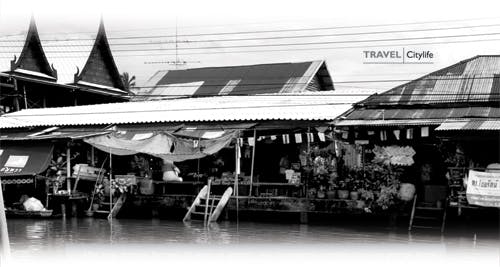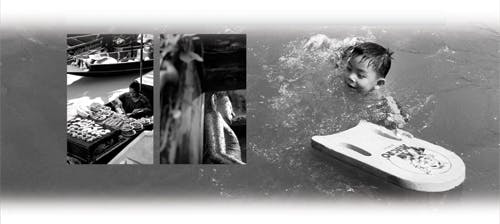Traditional wooden houses line the klong, market vendors wearing wide brimmed hats and smiles serve delicious steaming dishes and colourful sweets from their one-man-band boats, and if you’re lucky you may catch a glimpse of a tua hea (water lizard) carousing under the walkway boards.
Amphawa is famous for its atmosphere of the olden days and the traditional way of life in the central region of Thailand. Amphawa was honoured with an Asia Pacific cultural heritage award from UNESCO in 2008. The majority of tourists in Amphawa are Thai and there are very few foreigners. Perhaps it’s all for the best that Amphawa has not yet made its way into the Lonely Planet.
Bringing back wistful childhood memories for elders and providing novelty value for teenagers, Amphawa has something for everyone. Amphawa dominates a trend of nostalgia tourism in contemporary Thailand, such as visits to old markets or traditional houses. Other similar in-trend spots include Talad Roi Pee or Sam Chuk (one hundred year old market) and Talad Kao Hong (market with nine rooms) in Suphan Buri, as well as Plearnwan in Hua Hin, a fictional pastiche of a Thai village in the 1960s.

After lying dormant for over 30 years, an ancient floating market in Amphawa was brought back to life with a bang, this time not for locals, but for urban tourists, mainly Bangkokians, seeking a taste of the past. Amphawa holds rich cultural and historical worth regarding its past events, trade, agriculture, beliefs and activities of royal and local people over time. It was the birth place of King Rama II and an important source of produce and centre of trade for the kingdom’s capital cities.
Amphawa lies approximately 70 kilometres, roughly one hour’s drive, southwest of Bangkok, in Samut Songkhram province. The area is characterised by a network of klong (natural creeks or man-made canals). The region is naturally rich with an abundance of seafood, fruits and vegetables and is renowned for its pla tu (mackerel), salt fields and coconut palm sugar, all of which can be found at the floating market.
In the mornings, parting the dewy dawn mist, monks arrive at lodgings by boat, symbolic of ancient Thai society, you can take part or just observe as locals place food offerings into a monk’s bowl.
Amphawa is a real living village which has preserved the atmosphere of a traditional Thai waterside community. There are numerous idyllic photo opportunities and several activities to keep you occupied. Tasty and inexpensive food and drinks, such as fried oysters, noodles, grilled prawns, traditional Thai coffee and desserts, can be bought and devoured whilst absorbing in the surroundings. Try the famous kanom tuay served in the old fashioned way, in orange clay ramekins. Locals are generally friendly and helpful. I recommend staying over for one night, in a klong-side resort or home stay. Amphawa is most beautiful in the mornings before the tourists have arrived.
In the evenings you may take a boat trip, a bargain at only 60 baht per person, to observe the fireflies inhabiting lampoo trees, and yes they are real, no matter how much they look like flashing LEDs. Fireflies, iconic of Thailand’s rich and diverse landscape before mass housing developments and the destruction of wild environments, are one of the few animal attractions in contemporary Thailand that can be viewed in their natural habitat.
Around the market are various places of interest, a Thai desserts museum, a local artefacts museum, a Royal conservation project where you can see displays of local culture, as well as a museum dedicated to a local musician, Khru Eueh, famous throughout Thailand for his violin music. In the surrounding area there are a handful of attractions worth seeing including Rama 2 (the birth place of the famous monarch), a Siamese cat museum, a traditional Thai music museum, a Thai pottery factory and shop, a Siamese twin museum, Don Hoi Lot (famous for its seafood and razor clams), a cathedral and various stunning temples. Amphawa is a destination suitable for people of all ages.
The market runs every Friday, Saturday and Sunday from 12 to 8 p.m., lucky for those who like to get up late!

